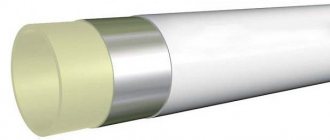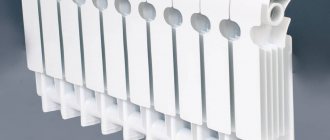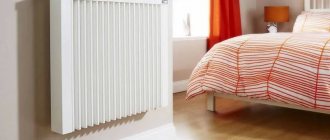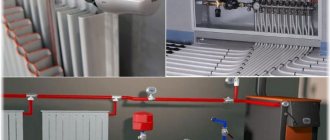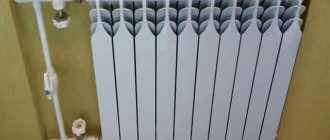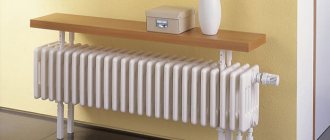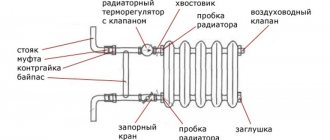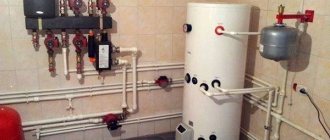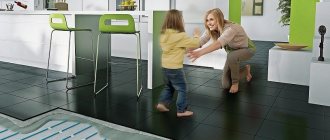Old cast iron radiators are becoming a thing of the past, and they have been replaced by improved heating devices with greater heat output. Not many people know which radiators are better for the home - aluminum or bimetallic. To choose the right radiator for your home or cottage, you should know the advantages, disadvantages and features of each individual type.
Choosing a heating radiator
Since the radiator is installed indoors, the aesthetic side of the item often becomes the decisive factor for home owners. And this is acceptable in cases where it is necessary to heat a cottage with its own heating system. But for a city apartment this approach is unacceptable, since a number of certain restrictions in operation immediately arise. When choosing a radiator, you need to look at its strength so that it can withstand the pressure of the heating system.
There are several types of water heating radiators. This is basically:
- cast iron;
- steel;
- aluminum;
- bimetallic.
In this article we will look at the last two types, their best and worst sides, as well as features of use.
What are the criteria for choosing radiators for an apartment?
When the weaknesses of central heating are already known, you can imagine what criteria good batteries should meet:
- For radiators, the pressure declared by the manufacturer must be greater than the pressure in the heating system. Let's look at the numbers as an example. In five-story buildings of the old layout, this indicator is no more than 5-8 atmospheres. Modern multi-storey buildings are heated under pressure up to 15 atmospheres;
- We will separately highlight the ability to resist water hammer. Because it is difficult to protect yourself from pressure changes when you are in an apartment, it is better to prevent this in advance. By the way, if you often hear noise and humming in the batteries, it is better to contact your utility service, as this may be causing problems with the pressure;
- The water quality in the old system is poor, so the batteries must adequately withstand its chemical attack without deforming. It is necessary to install radiators with a special coating on the inside or chemically neutral material for the walls. Their thickness should be such that sand particles and small stones do not rub it;
- When choosing suitable radiators for an apartment, it is important to remember their main function - to heat. It is better to choose radiators with high heat output;
- The appearance of the radiators also plays a role. It’s unlikely that anyone will like the old and scary cast-iron appliances of incomprehensible shape that used to stand in every corner. Batteries should look harmonious in the apartment;
- lifetime. There is nothing to comment here. The less time you have to bother with installing these large and expensive devices, the more profitable it is for the owners.
We recommend: What is the pressure in central heating batteries?
Which is better - aluminum or bimetallic?
When choosing between an aluminum and bimetallic radiator, it is worth knowing the features of each. Bimetallic radiators are practically no different in use from aluminum ones. That is why they are used in high-rise apartments and offices, as well as in enterprises. They are also often installed in private houses and cottages, but if we talk about feasibility, closed heating systems create up to 2 atmospheres, and therefore the use of aluminum analogues is considered more justified.
Aluminum appliances are imported mainly from Italy, and bimetallic appliances enter the market from China. Therefore, one can only guess about the quality of not only welding, but also materials. But it’s worth understanding each type of device in more detail to decide which radiator is better in your case – aluminum or bimetallic.
Cladding the basement of a house - which material is better?
How to choose and install a wireless video peephole
Comparative analysis of radiators
What is the first concern of the buyer of heating batteries? Three things:
- So that heating devices heat well and serve for a long time.
- Product price.
- Their appearance.
A comparison in appearance can be immediately ruled out, since the design of modern sectional radiators is almost the same, and the vast majority of products are coated with a durable white polymer coating. All that remains is to choose a heater at a height corresponding to its installation location.
Externally, bimetallic products are indistinguishable from aluminum
The first 2 points remain, by which it is worth judging which radiators are better - aluminum or bimetallic. In technical language, the comparison criteria sound like this:
- good heating is ensured by the heat transfer of the heating device;
- the duration of operation depends on the operating pressure and the ability to withstand the effects of low-quality coolant (corrosion resistance);
- The concept of price refers to 1 section of the device.
Reference. The need for bimetallic batteries arose due to high pressure in central heating systems of apartments and private houses, as well as due to the low quality of the coolant. Therefore, it is better to compare them with aluminum ones from this point of view.
Various types of side fins of sections
Comparing heat transfer
Aluminum and its alloys have excellent thermal conductivity of 220 W/m*K. For radiator silumin this figure is 150-180 W/m*K. In terms of heat transfer, only copper is better than them (λ = 380 W/m*K), but batteries are not made from it. In bimetallic radiators, a steel intermediary appears between the coolant and the aluminum body with much lower thermal conductivity - 70 W/m*K.
If we assume that the speed of water movement and its temperature are the same in devices made of silumin and bimetal, then the heat transfer of the latter will be less. Steel will not have time to take away as much heat from the coolant as silumin. This is in theory.
In practice, the heat transfer rates declared by manufacturers are almost the same for silumin and bimetallic sections. To verify this, just look at the table, which shows data for products from two well-known manufacturers - Global (Italy) and Rifar (Russia):
Note. The heat transfer values are indicated for certain conditions: the temperature difference between the coolant and the air in the room should be 70 °C (90 and 20 °C, respectively). This means that in reality the batteries will give off about 1.5 times less heat.
If we compare the sizes of the sections of the presented models, it will become noticeable that they are capable of transmitting approximately the same heat flow into the room. Hence the conclusion: both types of radiators heat equally efficiently and according to this criterion there is no difference between them.
Which batteries are more reliable?
The service life of heating devices operating in a central heating network depends on the corrosion resistance of the material and the pressure for which the radiator is designed. Regarding pressure, there are many horror stories floating around the Internet, their content boils down to one thing: aluminum sectional batteries cannot be installed in apartments with centralized heating, because they will be torn apart by water hammer and increased water pressure.
In fact, silumin products from all well-known manufacturers are designed for a working pressure of at least 16 Bar, and are tested at 24 Bar. This is despite the fact that the pressure in heating networks rarely reaches 14 Bar, taking into account tests and other operating conditions. As an example, the table shows the performance characteristics of products from several popular brands:
And to dispel the myth about bursting aluminum batteries, we suggest watching the video of our expert Vladimir Sukhorukov, where he conducts a tensile test of a steel radiator. Please note that steel appliances, unlike aluminum ones, are designed for a pressure of only 6 bar.
Sections of Global bimetallic models can withstand operating temperatures of up to 35 Bar, and are tested at 50 Bar. Characteristics from other brands are shown in the next table:
Such pressure indicators simply do not exist in any heating network, except for steam systems of industrial enterprises. Hence the logical question: why install a more expensive bimetal if aluminum is quite enough? Perhaps due to the corrosive effects of the coolant, which we will discuss later.
To make sure that your reasoning is correct, visit your heating supply company and ask to see data from pressure tests of the system (pressure testing is usually carried out at a pressure of 12 bar). And then compare them with the technical characteristics of heating devices of various types.
Sediment from the coolant in heating pipes and radiator channels.
Poor coolant in central heating systems is a problem in all countries of the post-Soviet space, resulting from the extreme deterioration of underground pipelines. Therefore, only cast iron batteries are “friendly” with such water; the rest face the following fate:
- Silumin remains resistant to corrosion if the pH value of the coolant does not leave the range of 7-8.5 units. A more acidic environment has a destructive effect on the alloy.
- Abrasive particles moving along with water through the channels of the heating device tirelessly bombard the surface of the aluminum alloy. True, a fistula from such exposure may appear many years later.
- The steel pipes of bimetallic radiators also corrode and become overgrown, although here too it will take quite a long time for the product to fail.
Leading manufacturers of silumin batteries practice applying a protective layer consisting of tri- or hexavalent chromium to the inner walls of the channels. Application method: electrochemical (passivation). Such measures practically equalize the chances of bimetallic and aluminum heating radiators in the fight against corrosion.
Which is cheaper?
According to general price statistics, bimetal costs on average 20-25% more than aluminum. At the same time, batteries with a steel frame have a limitation on the size of the flow area of the channels due to an additional element - a pipe. The remaining advantages and disadvantages of sectional alloy radiators are almost the same, as we had the opportunity to verify.
The difference in price is well reflected in the table with products of the same well-known brands:
Note: the cost of products from different companies is taken for the most popular size - 500 mm.
Pros and cons of aluminum radiators
Aluminum radiators are very light in weight, elegant from an aesthetic point of view and have high heat transfer. They can release about 50% of their heat by radiation, and the rest is realized by convection. Therefore, these heating devices are considered the most effective in heating a living space.
When installing a radiator, to reduce heat loss, it is worth placing a reflective insulator between the wall and the device. This way the heating will work to heat the room, not the wall.
A highly developed ribbed surface (meaning thin fins) is placed inside the section, which as a result makes it possible to increase the effective heat removal area to half a square meter. Thus, heat transfer is significantly increased. The small volume of water in the sections makes it possible to adjust the radiators using thermal heads. Aluminum radiators have low thermal inertia and the results in the operation of the thermal valve will become noticeable within ten minutes, which allows significant savings on heat resources (up to about 30%).
This is what can be said about the benefits. Speaking about the shortcomings, you should take into account the material from which the radiator is made. Aluminum, as a metal, has high chemical activity. This can be easily corrected with the help of an oxide film that forms a protective barrier so that the metal does not interact with other elements.
But aluminum products have their own fairly stringent requirements for the water that will pass through the system. So the pH should be approximately 8. The coolant should also be monitored for abrasive particles that can create wear and destroy the protective layer of the coolant. Therefore, the water in the heating system must undergo certain preparation. In real life, this is done at a thermal power plant.
Aluminum radiators are divided into cast and extruded. With cast ones, everything is clear - each section is cast as a single piece, to which the bottom parts are then welded. An extrusion radiator is produced by pressing an alloy through certain shapes and sections. In this way, profiles of greater length are obtained, which are later given the shape and dimensions for a specific order by cutting to specified sizes. At the end, the bottom and top parts are welded. Cast radiators are considered more reliable compared to extrusion ones.
The best aspects of aluminum alloy radiators are:
- High heat dissipation;
- Availability of prices;
- Light weight;
- Large flow area;
- Working pressure ranges from 10 to 16 atmospheres.
The disadvantages include:
- Potential corrosion if the coolant in the central heating system is of poor quality.
- A bleed valve is required to remove air from the upper manifold.
- For aluminum radiators, the most vulnerable point is the threaded connection of the sections .
Concluding from all of the above, these radiators are the most affordable, elegant and reliable when manufactured with high quality. Craftsmen recommend using them in private houses, apartments and offices of various heights.
Laminate or linoleum - which is better? Expert opinion
Reviews of acrylic bath liners
Hydrogen generator for heating a private home:
Types of aluminum radiators
There are three types of such heating devices, each of which is made in a certain way:
1. Sectional aluminum heating radiators cast under pressure. In the manufacture of such radiators, an alloy of aluminum and silicon is used. It comes in first and second grades. For example, European factories use only high-quality raw materials that meet the required standards.
Sometimes unscrupulous manufacturers use low-quality materials, which significantly deteriorates the quality of radiators and also shortens their service life. Heating devices made in this way are the most popular among Russian consumers.
2. Sectional extrusion radiators. In the manufacture of such devices, sections are welded together using upper and lower collectors. Some manufacturers glue them together with composite glue, which increases the likelihood of the devices leaking.
3. Aluminum heating radiators with anodized coating. This is a more expensive type of heating device, as it is made of aluminum that has undergone thorough cleaning. By being anodized, the material receives reliable surface protection from corrosion. These products have great heat transfer and a long service life. Due to the high price, such devices are in rather low demand among consumers.
Technical characteristics of aluminum radiators
To choose a quality device, you need to be guided by the following criteria:
1. Working pressure – from 6 to 24 atmospheres. 2. Power – from 82 to 212 W. 3. One section weighs no more than 1.5 kg. 4. The coolant temperature reaches 110 degrees. 5. The amount of water in 1 section is up to 0.46 l. 6. Service life – up to 20 years.
Pros and cons of bimetallic radiators
This type of heating device has an outer surface and fins made of aluminum, but the conductive channels of this product are made of steel. In simpler terms, the body of these radiators is made of aluminum, and steel tubes are embedded in the inside.
Many people, wanting to “hide” radiators, cover them with panels. As a result, up to 20% of heat is lost. That’s why many people complain about low-quality devices. If you want more heat, do not cover radiators with screens and panels.
The main advantages of bimetallic radiators are increased resistance to abrasive particles in the coolant and simply resistance to high operating pressure. The use of steel allows us to protect aluminum from contact with other substances, which makes the device resistant to chemical reactions, which means it will last quite a long time. It is worth noting that the use of steel in a vertical manifold makes it possible to increase the operating pressure. Even if in reality it usually does not exceed 15 atmospheres, but during installation you will be sure that the device is truly reliable.
The advantages of these radiators stem from the best aspects of aluminum and steel heating devices:
- Increased strength with the ability to withstand up to 40 atmospheres ;
- Durability . Service life is 20 years ;
- Modern design and pleasant aesthetic appearance;
- High heat dissipation.
The disadvantages of this device are also known:
- The hydraulic resistance of such radiators is higher than that of steel ones, and therefore more energy is required to pump the coolant , that is, water.
- Based on the features of production and high quality, the price of such a product will also be slightly higher than that of its aluminum counterpart.
Reviews of aluminum and bimetallic radiators
Reviews are quite ambiguous, since, judging by consumer testimonies, it is the quality of pipe production that plays a greater role. Therefore, Italian-made aluminum appliances are in great demand on the market.
“When choosing a radiator, I was primarily focused not on appearance, but on quality and reliability. Therefore, I decided to take aluminum radiators from the Global brand for the cottage. The third year has passed and there are no failures. They were easy to install due to their weight.” – Alexey, 43 years old, Moscow.
“I bought bimetallic radiators because I heard a lot that they are more reliable and of higher quality. Steel inserts and other design advantages. One of the radiators leaked in the fourth year. Just think - no steel pipes can withstand manufacturing defects or our water.” — Sergey, 33 years old, Sevastopol.
So, mainly aluminum pipes from well-known brands like Global or Kermi are used for houses and cottages. In addition, it is worth remembering that an Italian radiator will not necessarily be made in Italy. For a real Italian radiator, the retail price is approximately 500 rubles per section. A high-quality Russian or Chinese radiator varies between 400 rubles. Lower prices indicate worse quality.
Only steel radiators are produced in Germany, and therefore do not believe the tales about German heating “monsters”. If you are designing a heating system based on plastic pipes, then it is worth considering the fact that the data sheets indicate the power at a water temperature of 90 degrees. But at a water temperature of 70 degrees, the radiator power decreases by a third. Therefore, be careful when buying a radiator for your home, so that the choice does not turn out to be a bad investment of money and effort.
You can also watch a video that may help you with your choice:
conclusions
Now it’s easier for you to make a choice: which radiator to install in your apartment - after all, out of four options there are only two left. Neither steel nor aluminum devices will withstand pressure surges and aggressive effects of domestic coolant. What to buy - focus on your budget and the characteristics of certain models. Here are some tips:
- in older houses you can install cast iron appliances. If you live in a multi-storey building where the pressure of the heating system is higher, then it is better to buy bimetallic radiators;
- If your old batteries are made of cast iron, then you can choose one of two options: bimetal and cast iron. If you want to replace batteries made from a different material, it is better to buy bimetallic ones.
YouTube responded with an error: The request cannot be completed because you have exceeded your quota.
- Related Posts
- How can you paint central heating radiators?
- Is it possible to install bimetallic radiators on central heating?
- How to repair a cast iron heating radiator with your own hands?
- What characteristics are used to choose autonomous heating batteries?
- How to repair bimetallic heating radiators with your own hands?
- What are the best radiators for central heating?
